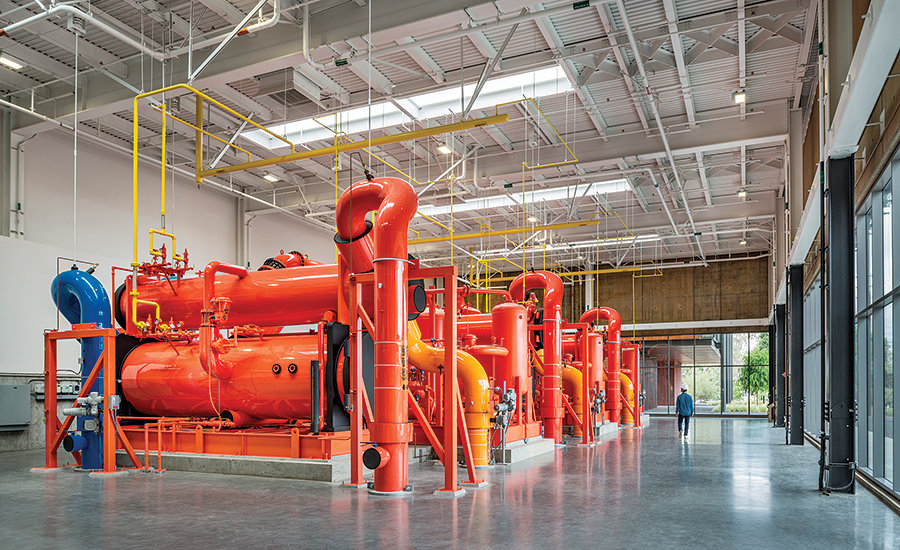Central Energy Facility

Welcome to a new kind of sustainable power
The Central Energy Facility (CEF) is economical, robust, efficient, and most importantly, sustainable. The facility houses three heat recovery water tanks, a high-voltage substation linked to the grid, and a novel heat recovery system.
Sustainability was not only considered in the mechanical design of CEF, but also was a guiding principle of the entire project. In the spirit of innovation, the facility also includes administrative and collaborative classroom/meeting spaces to encourage turning ideas and projects into reality as a "living lab." A strategic, open-air floor plan facilitates cross breezes while LED lighting is used to complement the natural lighting. The ceiling panels and flooring even assist with climate control by utilizing radiant heat. Learn more about the award-winning architectural firm who designed the space.
The CEF is the heart of Stanford Energy Systems Innovations (SESI) and houses multiple, groundbreaking innovations and a multifaceted system that provides Stanford with sustainable, cost efficient, thermal energy.
Learn more:
Heat Recovery

Eighty-eight percent of the heating load on campus is generated purely by waste heat. This is the miraculous reality of the CEF heat recovery system, and relies on the fact that Stanford campus concurrently requires both heating and cooling. At Stanford there is a 70% real-time overlap of heating and cooling demands due to the wide variety of activities on campus. This overlap comes with an opportunity – cooling water down to serve some parts of campus creates leftover heat which can be used to heat other parts of campus. This efficient use of heat waste reduces the need for both evaporative cooling and burning fossil fuels for heating purposes. As an added bonus, the system also reduces total campus water consumption by 18%. In this way, locations around campus and the medical center can all have their heating and cooling needs met sustainably and cost efficiently through CEF.
Each heat recovery chiller (HRC) has a 2,500-ton cooling capacity for chilled water and can simultaneously produce 41 million BTUs of heat per hour. That is a large enough capacity to cool and heat approximately 1000 houses simultaneously. Suffice to say that the CEF HRCs are the first of this size and very powerful.
Learn more about heat recovery and how you can do it too.
Thermal Storage

While the recovery of heat is the key to the system’s sustainable functionality, thermal storage is the key to its optimization. Thermal storage allows the CEF to maximally leverage heat recovery by leveling energy demand by the campus. Thermal storage tanks mean that water can be heated or cooled at optimal times, rather than when it is needed. This gives the CEF a lot of flexibility, increasing both energy and financial efficiency.
The storage tanks avoid the need for additional heat pumps, chillers, and hot water generators to meet campus needs. Instead, thermal tanks can handle the equivalent capacity at a much lower cost. Equipment can be run at optimal load settings and at times with the lowest energy pricing. The backup regular chillers can be used when outside air temperatures and humidity favor evaporative cooling. The campus also has varying thermal energy needs.
In order to garner these system benefits, the storage tanks are massive. In fact, when the thermal energy storage system was built, it was the largest with heat recovery in all of North America. The system is comparable to about 492 MWh of electrical storage or that of a very significant energy storage facility. Each chilled water tank has a capacity of 4.3 million gallons and together provides 90,000 cooling ton-hours of energy. The hot water tank, on the other hand, holds 2.3 million gallons, which is 600 million BTU hours of energy.
Model Predictive Software

Although capitalizing on Stanford’s overlap of heating and cooling demands makes sense in theory, making it work in practice requires careful optimization. Each HRC uses about 5% of the total electricity used by Stanford which is quite significant. The university must be adept at how and when the HRCs are used in order to minimize electrical impact on the grid and the corresponding ‘demand’ charges paid for its use. To address this, Stanford invented a new central energy plant optimization program to provide optimal service reliability and economic performance.
Stanford collaborated with Johnson Controls to transform a new patented plant optimization model into industrial-grade software, named Central Energy Plant Optimization Model or CEPOM. Sometimes this software is referred to as EOS, CPO or OpenBlue, but the function remains the same. CEPOM is hardwired into the energy facility control system and works as a kind of “autopilot" for the plant. The system models potential energy demands and sends recommendations for optimal performance every 15 minutes. It can either be used as a supplementary advisory or it can run fully automated. Regardless, the control room is staffed 24/7 to monitor operations.
CEPOM’s recommendations are based on over 1220 variables, such as building occupancy, ambient conditions, time of year, projected energy prices, weather forecast, current system conditions, etc. This continuous forward-looking analysis is critical, not only for energy optimization but also to minimize the overall electrical footprint of the university on the grid.
For more information about the CEPOM system, see the following video:
